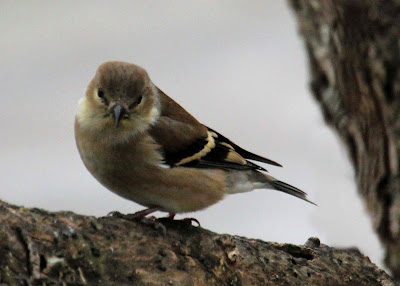What a weird season
of weather. A little snow, ice, sleet, a lot of rain, freeze and
thaw, all in the same day!
We took advantage of
a recent warm afternoon to take a little hike into Hoffman Preserve.
As reported in other posts (here and here), the
Hoffman Evergreen Preserve is a very special place, beloved by many
and quite unique in its forest makeup. It has also succumbed to the
ravages of old age, disease and infestations over the last decade.
The results are dead and dying trees throughout much of the preserve,
creating a danger for hikers, and an almost sterile habitat with
little wildlife diversity. A plan is underway to restore the forest
health, which will likely take years, but the work is beginning.
On this day, we
walked into the quiet woods, after we had had snow and sleet the
night before. Much of the snow elsewhere had melted, but in the
darker areas of the wood, it remained. The hardened trails with
frozen ground had a layer of ice, topped with snow, topped with
inches of water in many places. Good footwear was essential, and
from the look of the footprints in some areas, the conditions didn’t
deter everyone.
 |
| Informing the public is so important to a project like this. |
 |
| The slushy trails apparently did not deter dedicated hikers. |
 |
| Trees continued to crack and fall throughout the winter, making it hard for stewards to keep up. |
An expert's eye
We knew the
professional forester had been in to begin his work of assessing the
forest more closely. He is literally checking each tree for its
health, its potential benefit to the forest, and marking it for
removal if he felt that by doing so, it would be a better option.
I was able to walk with the forester earlier in the project, and we
wandered off trails, looking at several examples of how he was
choosing his trees. There are some that definitely need to go: these
are the dead and dying oaks. Over these last years, so many have been
stressed, to death, by conditions of insect infestation and drought.
Many have fallen already. There may be some use for the wood if
they are removed now, and it will also make the forest safer. Many
hemlocks are marked for removal because many of them are also dead,
and if not, they are crowding others which are healthier and show
promise. It is our hope that we can support the evergreen appearance
and habitats in the preserve.
Trees to preserve
are those that offer greater benefit to wildlife: White Oaks,
Hickories, Beech. These provide nuts and seeds. These will also be
the parent trees for the next generations of seedlings that will grow
in the new openings. We will also be keeping some of the dead trees,
if they are off the trailed areas, as these will provide an important
element for the health of the new forest. The dead trees will
provide places for insects to dwell, inviting birds, especially
woodpeckers, to forage and to nest. Larger holes will be great
denning areas for several species of mammals, including the three
species of squirrels we have in the area. When trees fall, they
continue to serve an important purpose as shelter for many other
species of creatures. Woody debris on the ground will restore
nutrients to the earth.
As we walked the
areas first marked, the blue trail heading south and the yellow
trail, we took note of the trees, the healthy ones, the sick ones,
the crowded ones. We looked at the very barren understory areas. We
heard no birds at all. Only in one area, close to the edge of the
woods, did we see the footprints of a lone deer. Only one on the
whole hike.
 |
| Dead trees remain valuable for wildlife of all kinds, as long as they are away from the trails. |
 |
| Trees show several kinds of marks, each with specific meaning to the forester. |
 |
| Areas near special features or wetlands have been flagged to remain undisturbed. |
 |
| By thinning the hemlocks here, those still alive will have room to grow and bring back the lovely green feeling we love. |
Hike with care
The preserve is
still open for hiking while this phase of preparation is underway.
It is an interesting education to observe and understand the process
leading up to the actual work. We invite you all to hike, learn, and
take note. It will be a disruption this spring, no doubt. All the
rain this winter has made the ground too wet to try and bring in big
equipment . Frozen solid ground is good, but the thaw will bring
more mud. We are not sure when the heavy work will begin.
As the next seasons progress, the greening of summer will help cover
some of the scars, and the sun will enter the woodlands as it hadn’t
been able to for so long. I am looking forward to that sun for so
many reasons.
I hope many of those
who love Hoffman will join us in documenting the renewed life there.
But first, we have to get past this crazy winter.
Photographs by Beth
Sullivan.





















